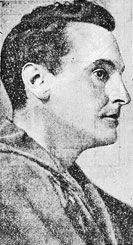| Join | Official Historian | City of Stamford | Blog | About Us | |
| Jewish Historical Society | Civil War Roundtable | Contact Us | |
|
|
|
|
The Stamford Historical Society PresentsPortrait of a Family: Stamford through the Legacy of the Davenports
Benjamin Butler Davenport 1871–1958
Benjamin Butler Davenport was a most creative and idealistic individual. A 19th—and 20th—century man, he was one of a kind. Generations of solid citizens, active in the law, the ministry, investments and other prosaic areas, produced a man dedicated to the theatre and unique in his attitude towards it. When first Benjamin Butler informed his parents of his intent to make the theatre his life, they were not happy with his decision. He persuaded them of his seriousness, however, and they gave their consent and encouragement. He then began his career acting in a company of Charles Frohmann's. The Frohmanns, also of Stamford, were a family of theatrical producers and Davenport first appeared in their production of The Other Man. Although his part was small, Frohmann thought it required a particular talent and was pleased with Davenport’s effort. In his teens and early twenties, Benjamin Butler worked in Augustin Daly’s repertory company as an understudy and bit player, and then acted in Frohmann’s company, rubbing elbows with theatrical greats, Sarah Bernhardt, Eleanora Duse and others. Family financial declines forced him to give up the theatre, at least temporarily, and sell real estate for what he termed “eight black years.” Then, in 1909, Davenport announced he was building a new playhouse on 63rd Street in New York City, for a stock company to produce modern American plays. Unfortunately, 1909 was not to be a good year for Davenport. His theatre’s construction made it to the second story when the backer’s money ran out and the project was abandoned. It was back to selling real estate for Benjamin Butler. In his first few years as a producer, he did collect small fees for tickets, but his strong convictions for a free theater won out and from then on he never charged admission to his productions. Davenport’s career as a theatrical entrepreneur brought him correspondence from people such as George M. Cohan, Katherine Cornell, and others. Some of his “iconoclastic” ideas led him into contact with those in the labor movement, where there was interest in presenting drama as part of their propaganda. Davenport’s interest in writing and producing plays dealing with social problems and controversies was a bridge between the two. Among others, he had some correspondence with Emma Goldman. Goldman was a well-known socialist and anarchist who served two years in prison for her activities on behalf of the anarchist movement. Goldman lectured on war, religion and drama. Her lecture on American drama included plays by Benjamin Butler in a series introduced as The Modern Drama Against the Tyranny of the Past. Eventually, Emma Goldman was deported back to her homeland in Russia. In 1911/1912 Benjamin Butler Davenport realized part of his life’s dream in Stamford. On the 73 acre Davenport estate on Davenport Ridge, near New Canaan, he built The Bramhall Playhouse. Seating about 200, with a small balcony, there were four dressing rooms, a green room and a loft office. All performances were free, donations and contributions welcomed. Many of the plays were written by Davenport and usually he performed in them as well. He frequently produced Hamlet, with himself in the lead. The name Bramhall appeared many years ago in his genealogy. In Cheshire, Great Britain there is the handsome, well preserved Bramall Hall, the oldest parts of which date to the 14th century. Here the Davenports resided for 500 years. The grounds were designed by the eminent English landscape gardener, Capability Brown. Benjamin Butler’s summer theatre at Davenport Ridge in Stamford did very well, with matinees as well as evening performances most days of the week. Well-attended, there were many times upwards of 100 people turned away for lack of space. Ultimately his fortunes declined once more; the theatre was closed and the family began to sell off acreage for development, although the historic 1775 house still remains on Davenport Ridge Road. He occupied an apartment above his New York City theatre building until his death at age 86, in 1958. Night after night he declared to his audiences, “I’ve been tremendously rich in everything but money.” On display in the exhibit:Various documents and flyers from the New York Public Library's Digital Collection, including: Copy of Letter from Equity Players, New York Courtesy Amherst College Library Copy of Programme of “Hamlet” |
||
|
|
